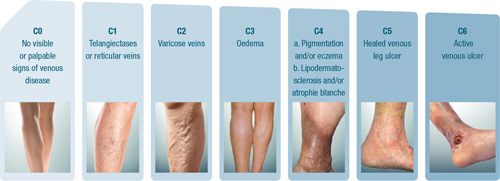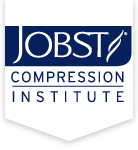There are multiple causes for venous disorders, with symptoms varying by disorder. Symptoms range in severity from minor discomfort in the extremities to skin ulcers and pulmonary embolisms brought on by a blood clot traveling to the lungs.
Minor Symptoms
- Itchy Legs
- Feeling of weakness in the legs
- Swelling in the legs or ankles
- Changes in skin color, especially in lower leg
Moderate Symptoms
- Aching or throbbing in legs
- A heavy feeling in the legs
- Leg cramps
- Development of thicker skin in legs
- Varicose veins
- Tight feeling in the calf muscle
Severe Symptoms
- Pain when standing that improves when legs are elevated
- Leg ulcers
Symptoms of Deep Vein Thrombosis (DVT)
- Redness on the leg
- Sudden swelling of the leg
- Skin that is warm to the touch in the area that is swollen
- Pain or tenderness in the leg, which often starts in the calf, feels like a cramp and may present only when standing or ambulatory
Symptoms of a Pulmonary Embolism
Venous disorders, especially deep vein thrombosis, can lead to a pulmonary embolism — a blood clot that travels to the lungs. There are several warning signs for pulmonary embolism that require immediate treatment, including:
- Sudden feeling of shortness of breath
- Chest pain that worsens when taking deep breaths
- Lightheadedness or dizziness
- Sudden fainting
- Increased heart rate
- Coughing up blood
Pulmonary embolisms can be fatal, but receiving immediate medical attention greatly improves the chance for survival. Proactively treating venous disorders can greatly reduce the risk for pulmonary embolisms.
CEAP Classification System
The first step towards managing CVD is classifying your patient’s symptoms. A clinical classification system known as CEAP – Clinical, Etiology, Anatomic and Pathophysiology – was developed in 1994 by an international consensus conference to provide uniformity in reporting, diagnosis and managing CVD.
The CEAP classification system focuses on the clinical aspects on this site, which range from C0, with no clinical or visible signs, to C6, when venous leg ulcers (VLU) are present.

About 50% of women and 40% of men in the United States suffer from some type of vein problem.
Source: "EPublications." Varicose Veins and Spider Veins Fact Sheet. Ed. Robert J. Min. Women's Health, US Department of Health and Human Services, 16 July 2012. Web. 18 June 2015.



